Author(s): Shriyash Shete
This paper introduces the Ansys AR app, an innovative integration of Augmented Reality (AR) with Ansys Discovery, aimed at revolutionizing the 3D design and simulation process. Anticipating the CAD market’s growth, the study explores the transformative potential of AR in enhancing the capabilities of traditional CAD technologies. The user-centric Ansys AR app offers an immersive, interactive experience, allowing users to visualize and manipulate 3D models in real-world settings. The paper demonstrates the app’s effectiveness in improving design efficiency and communication through comprehensive user research, design conceptualization, and usability studies. It concludes with prospects for future enhancements, highlighting the app’s potential to reshape collaborative engineering and design practices.
3D Design and Simulation are crucial in developing products, with the global market for Computer-aided Design (CAD) projected to reach a value of $20,039.4 million by 2033 [1]. The market’s rapid growth, coupled with the increasing complexity of 3D design and simulation tasks and the advancements in emerging technologies, has sparked a keen interest in innovation among companies for a competitive edge. Experts suggest that innovations driven by technology offer significant prospects for businesses to sustain their competitive advantage. Augmented Reality (AR), a key component of Industry 4.0, has particularly captured significant attention in recent years. AR enables users to not only passively view information but also to actively engage with and interact with the content, as well as collaborate in real-time from various locations. The growing industrial interest in AR, evident in sectors like gaming, automotive, aerospace, military, and marketing, is now influencing the CAD and simulation sector. AR is poised to revolutionize the 3D design and simulation field, offering companies new opportunities to enhance their competitive standing [2,3].
In the realm of engineering simulation, Ansys Discovery emerges as a pivotal tool developed by Ansys, Inc., renowned for its innovative simulation software. This tool revolutionizes product development by offering real-time, interactive physics-based simulation capabilities, thereby significantly accelerating the 3D design and innovation process. Its user-friendly interface is crafted to cater to a broad spectrum of users, including those with limited simulation expertise. Notably, Ansys Discovery stands out for its versatile multi- physics capabilities, encompassing structural, fluid, thermal, and modal analyses. This enables a comprehensive evaluation of a product’s multifaceted performance attributes. Additionally, the tool’s integrated geometry modeling features facilitate rapid model creation and modification, streamlining the design workflow. With options for cloud-based computing, the tool offers enhanced flexibility and computational power, making it a valuable asset across diverse industries such as aerospace, automotive, electronics, energy, and healthcare [4].
In this paper, we propose an innovative way to seamlessly integrate Augmented Reality/Virtual Reality (AR/VR) technology with Ansys Discovery software to enhance further its capabilities in optimizing product designs, minimizing the reliance on physical prototypes, and shortening the market entry time frames in contemporary engineering practices. Thus, the research question we aim to address is: How might we integrate new technologies and extend the power of simulation-driven design for Ansys Discovery users to make their product development process more efficient? The final design is represented in the form of a high-fidelity prototype. We have used automobile exterior and interior 3D design as an example for this case study.
Since the advent of CAD systems, it has made it possible to see three dimensions of the product before it is manufactured. At present day, CAD models are being used beyond 3D modeling. However, there is still a gap in that CAD applications do not provide immersive visualization and interactive simulations, such as that seen in extended realities (Virtual Reality (VR), Augmented Reality (AR), and Mixed Reality (MR)). Many intricate products in the real world require detailed conceptualization before being made. It’s tough to mimic a real 3D world with traditional CAD technologies. However, in extended reality technology, the model created in CAD software is loaded into VR, AR, and MR platformsfor immersive simulation and detailed conceptualization [5,6,7].
Tablet and smartphone AR applications such as Shapr3D, Adobe Aero and Ikea AR app allow users to create, place and visualize a 3D model in the real environment [8,9,10].
To understand the existing competitors of Ansys Discovery, we conducted a competitors analysis with 5 direct and 3 indirect competitors. We present some of the findings in Table 1:
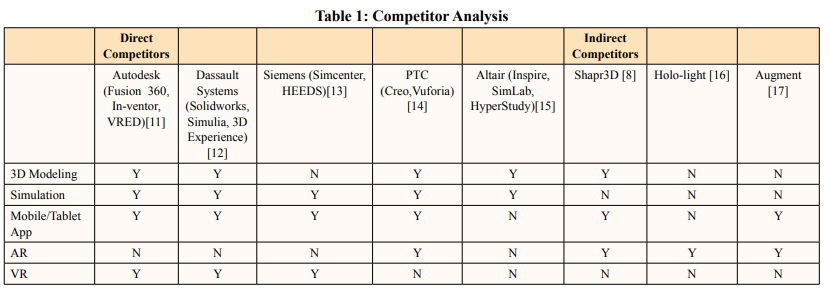
We conducted six interviews with questions related to the Ansys Discovery product, Product Development process and integration with AR/VR technology to understand the context in which design engineers and engineering analysts work, the user behavior and future possibilities when it comes to interacting with existing Computer-aided Design software.
We found that users 50-75% of the time in a typical week is spent on CAD and simulation software. They are productivity- conscious and try to better the productivity and workflow experience with multiple screens, keyboard shortcuts, and extra gadgets. They have high computer literacy. While laptops and desktops are frequently used for work, they use smartphones, tablets and gaming systems outside of work.
We asked Ansys Discovery-related questions and found that overall users were satisfied with the product. Participants mentioned that 3D model creation and editing is precise with keyboard and mouse. They also like that simulation results with Ansys Discovery are accurate compared to other tools. The use of Ansys Discovery is cost-efficient as it saves engineering labor, material and analysis costs. Moreover, the performance of Ansys Discovery is known for the speed and time saved in the product development lifecycle as users can create and test multiple variations quickly. Users stated that some of the UI elements feel modern but they can be less cluttered.
When we delved deeper into the product development process (see Figure 1), we found that the users’ struggle lies not in creating the 3D models but in visualizing, presenting and communicating their ideas to stakeholders efficiently and effectively. One of the participants said “I had a hard time explaining a complex 3D model in a 2D screen. People take longer to understand and imagine it. There are often delays in our process due to extra time that goes into bringing everyone on the same page.” Remote work makes collaboration and communication even more challenging. Another participant mentioned “With remote work and globally distributed teams, we designers can’t be in the same room with our clients to discuss the designs. We rely on videos or screenshots of the 3D model which is not enough to get the point across.” Many participants mentioned the need to bring 3D digital models to the real world so that they can simulate and interact with them to make decisions faster. For example, a participant emphasized this by saying “If I design a toaster, I would want to see it in real size and how it will look in the context of a kitchen. If it’s a car, I would like to walk around a life-sized car and even sit inside.”
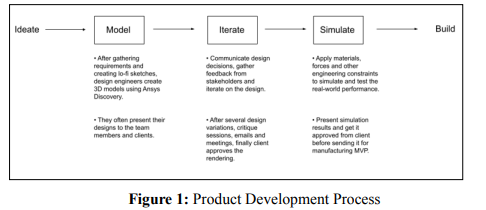
When asked about leveraging future technology, we derived the following key insights:
Discovery users are adept with keyboard and mouse input modes so they prefer emerging technologies for the communication aspect of the process and not much for the creation.
3D Designers’ goal is to get the buy-in from their stakeholders as early as possible with a minimum number of errors and revisions
People find new AR/VR devices cool but these technologies usually do not fit well with their everyday workflow and systems with remote work
People hesitate to embrace new technology gadgets because interactions don’t feel natural, familiar and intuitive yet.
We observed general users interacting with AR, MR and VR devices and we used them ourselves to gain first-hand experience. Also, we studied several different types of tools and experiences available in the market. Our findings for the technology and experience analysis are shown in Table 2:
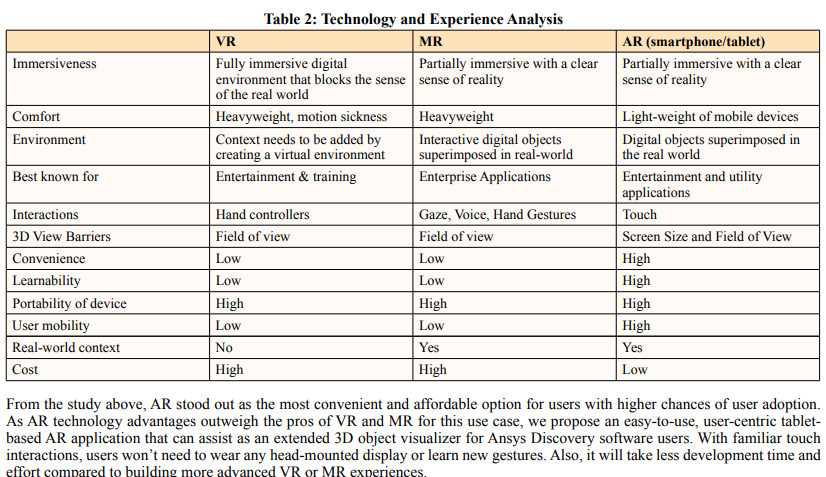
We suggest the AR app with the interaction flow so that it fits in the user’s current process with the Ansys Discovery tool seamlessly (See Figure 2). First, design engineers will create the 3D model in desktop-based Ansys Discovery as they do it today. They will send the 3D model to the Ansys AR app for their stakeholder’s visualization. The 3D design can be viewed in real-life dimensions using the AR app where users can interact with the digital superimposed object. The user can also walk around the virtual object and add feedback in the form of notes/comments. Lastly, after viewing and taking in- context notes, they can send them back to the desktop app so that the design engineer can make the changes based on the feedback using the familiar software of Ansys Discovery.
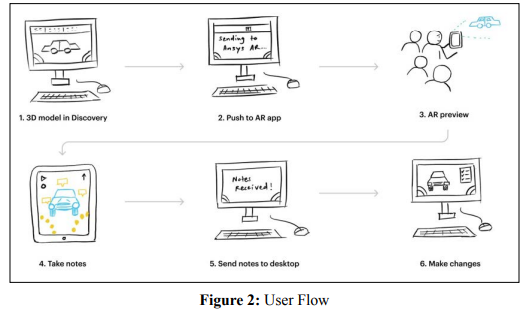
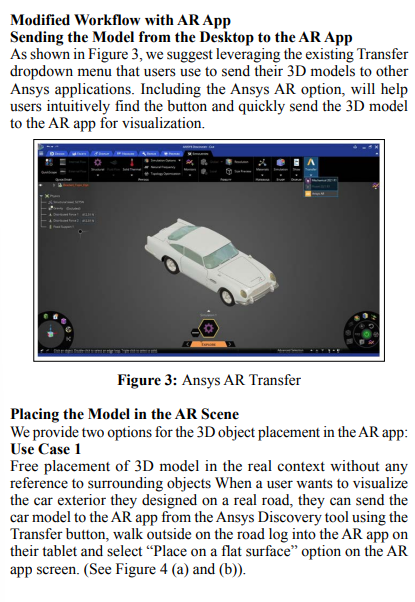
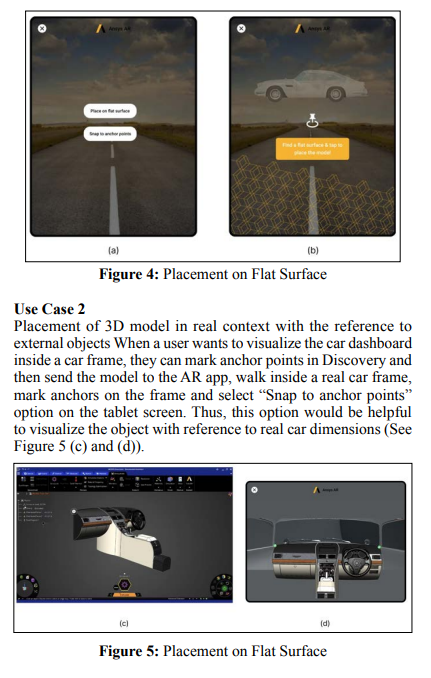
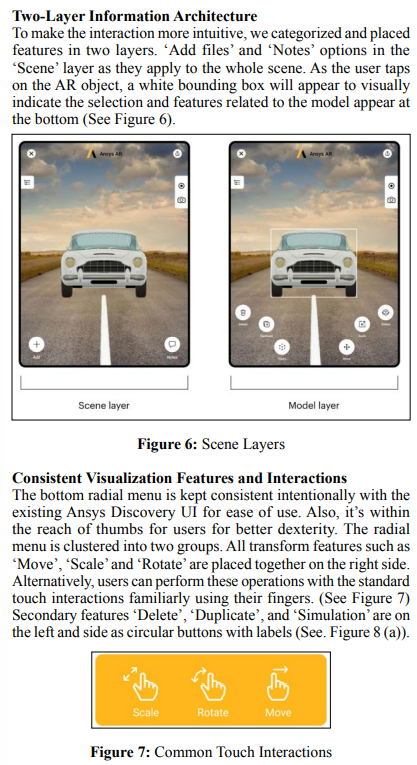
Another feature that’s consistent with Ansys Discovery software is the ‘Physics Tree’ at the top left where users can see the breakdown of the 3D model assembly at a granular level. They can view and hide the individual parts and layers as necessary. On the top right side, standard ‘Video’ and ‘Screenshot’ options will make the recording and sharing of the design details easier across various mediums. (See Figure 8 (b))
View function is also consistent with the desktop tool which is intended to help users visualize the 3D model in three useful formats: i) Wireframe ii) Transparent iii) Simulation. Thus, with this AR app, users can not only bring their 3D model to the realworld context but they can also view the simulation results. As an example, the Figure 8 (c) shows aerodynamics and wind tunnel simulation on a car model.
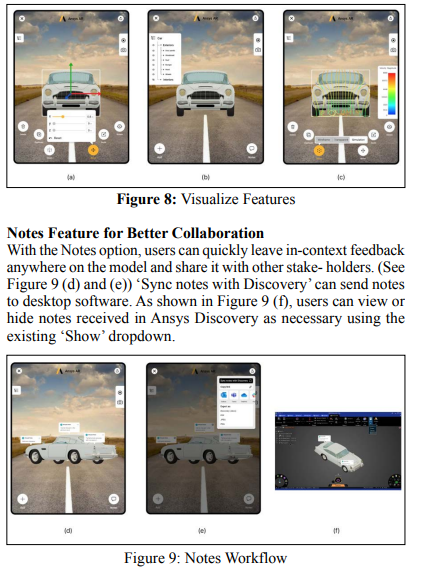
We conducted a moderated usability test with 6 Ansys Discovery users using a high-fidelity Figma prototype. The test was divided into two parts: task analysis and cognitive analysis.
Task analysis consisted of 3 tasks for users to perform: i) Send car model to AR app, ii)Place model on the road, iii) take notes and send them to desktop software.
Cognitive analysis had several questions to learn how well users understand UI and features: i) Does the grouping of features make sense? ii) How would you perform the ‘Move’, ‘Scale’ and ‘Rotate’ options without using the buttons? iii) What else would you like to see in the UI?
The overall feedback was very positive. The users appreciated the idea of the AR app as an add-on to the Ansys Discovery software. 90% of the users were able to perform the tasks successfully and were very satisfied with the design. 50% of the users asked about the interactions with Stylus for leaving notes.
In future iterations of this design, we would be incorporating the user feedback and suggestions we gathered which include:
The proposed Ansys AR app concept represents a significant step in bridging the gap between advanced 3D design and immersive visualization, thereby enhancing the overall product development process. By integrating Augmented Reality (AR) with the robust capabilities of Ansys Discovery, this concept not only addresses the current limitations of CAD technologies but also unlocks new potentials in collaborative design and simulation. The user-centric design of the AR app, prioritizing ease of use, accessibility, and seamless integration with existing workflows, reflects a thoughtful approach to technological innovation. The positive feedback from preliminary usability studies further underscores its potential to revolutionize the way designers and engineers interact with their creations. Looking ahead, the continuous refinement of this concept, including the integration of real-time syncing, expanded functionalities, and varied interaction modes, promises to further solidify AR’s role as a transformative tool in the realm of engineering and design simulation. This initiative, therefore, stands as a testament to the power of emerging technologies in reshaping industry standards and enhancing the efficiency, accuracy, and communicative power of design processes.
